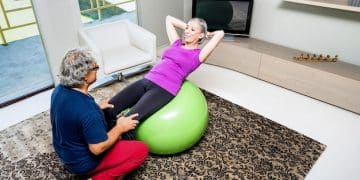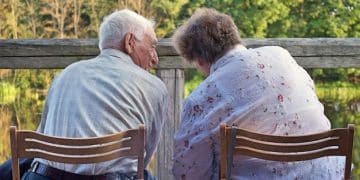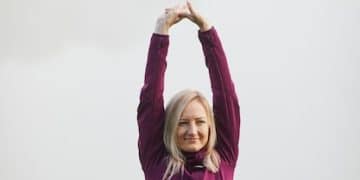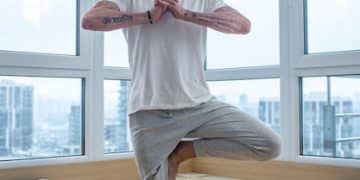Tai Chi Benefits for Seniors: Balance & Stress Reduction Boost
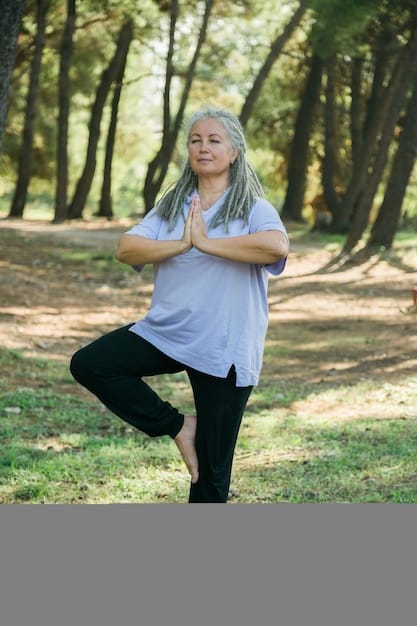
Tai Chi demonstrably enhances balance and reduces stress in seniors by promoting mindful movement, strengthening core muscles, and fostering mental tranquility, making it a powerful, low-impact exercise for overall well-being.
As we age, maintaining physical and mental well-being becomes increasingly vital. Among the various practices gaining prominence for their holistic benefits, What are the Benefits of Tai Chi for Seniors in Improving Balance and Reducing Stress by 10%? stands out as a gentle yet profound exercise. This ancient Chinese martial art, often described as “meditation in motion,” offers a compelling pathway to enhanced quality of life, particularly for older adults seeking to mitigate common age-related challenges.
Understanding Tai Chi: More Than Just Gentle Movement
Tai Chi, often perceived as a slow, graceful dance, is in fact a sophisticated system of movements, breathing exercises, and meditation rooted in ancient Chinese philosophy. Its origins trace back centuries, initially as a martial art form, but over time, it evolved to emphasize health and longevity. For seniors, its low-impact nature makes it an accessible and safe activity, offering myriad physical and psychological benefits without the strain associated with more vigorous exercises.
The core principles of Tai Chi revolve around fluidity, balance, and controlled breathing. Practitioners move through a series of forms, or sequences, maintaining a continuous, unhurried flow. This deliberate pace allows for deep engagement with each movement, promoting body awareness and mindfulness. Unlike brisk aerobic exercises, Tai Chi focuses on internal strength and mental clarity, contributing to a sense of calm and centeredness.
The Philosophy Behind the Flow
At its heart, Tai Chi embodies the principles of Yin and Yang, the complementary forces in the universe. Movements transition smoothly between opposing states – expansion and contraction, rising and falling – fostering equilibrium within the body. This philosophical underpinning translates directly into physical benefits, as the continuous shifts and weight transfers inherent in Tai Chi forms naturally improve one’s sense of balance and coordination.
- Mind-Body Connection: Tai Chi emphasizes bringing awareness to the present moment, integrating physical movement with mental focus.
- Chi (Qi) Cultivation: The practice aims to cultivate and enhance the flow of “Chi,” or vital life energy, throughout the body, promoting health and vitality.
- Gentle Resistance: Although movements are slow, they engage muscles subtly, building strength and flexibility over time without excessive strain.
Ultimately, understanding Tai Chi as more than just a physical exercise—seeing it as a holistic practice that integrates mind, body, and spirit—is crucial for appreciating its full spectrum of benefits, especially for the senior population.
Enhancing Balance: A Cornerstone Benefit for Seniors
One of the most critical aspects of healthy aging is maintaining good balance. Falls are a leading cause of injury among seniors, often resulting in fractures, head trauma, and a significant reduction in independence. Tai Chi actively addresses this concern, making it an invaluable tool for fall prevention.
The movements in Tai Chi naturally challenge and refine balance. As practitioners shift their weight from one leg to another, hold single-leg stances, and move through various postures, their proprioceptive system – the body’s sense of its position in space – is constantly engaged and improved. This continuous, gentle challenge strengthens the muscles responsible for stability, particularly in the core and lower body, which are vital for maintaining an upright posture and preventing accidental tumbles.
How Tai Chi Specifically Improves Stability
Beyond simply strengthening muscles, Tai Chi enhances balance by cultivating a heightened body awareness. The deliberate nature of each movement encourages individuals to pay close attention to their center of gravity, foot placement, and the subtle adjustments required to maintain equilibrium. This mindful practice translates into improved reactions in daily life, enabling seniors to better adapt to uneven surfaces or sudden shifts in balance.
- Strengthened Ankles and Knees: The slow, controlled movements build endurance and resilience in key stabilizing joints.
- Improved Proprioception: Regular practice enhances the body’s self-awareness, improving coordination and spatial orientation.
- Enhanced Core Strength: Many Tai Chi forms naturally engage the abdominal and back muscles, which are fundamental for overall stability.
Research consistently supports Tai Chi’s efficacy in balance improvement. Studies involving older adults have shown significant reductions in fall rates among those who regularly practice Tai Chi, underscoring its role as a practical and enjoyable intervention for senior safety.
Reducing Stress and Anxiety: The Calming Power of Tai Chi
Beyond its physical attributes, Tai Chi is a well-regarded practice for its profound impact on mental well-being. For seniors, dealing with chronic conditions, loss of loved ones, or transitions in lifestyle can often lead to increased levels of stress, anxiety, and even depression. Tai Chi offers a gentle yet powerful antidote, promoting a profound sense of calm and mental clarity.
The meditative aspect of Tai Chi is central to its stress-reducing capabilities. The focus on slow, deliberate movements and deep, diaphragmatic breathing helps quiet the “noise” of daily worries. This practice encourages individuals to be fully present in the moment, diverting attention away from stressful thoughts and fostering a state of mindful relaxation. The rhythmic, repetitive nature of the forms can induce a similar state to meditation, lowering heart rate and blood pressure, and reducing the production of stress hormones like cortisol.
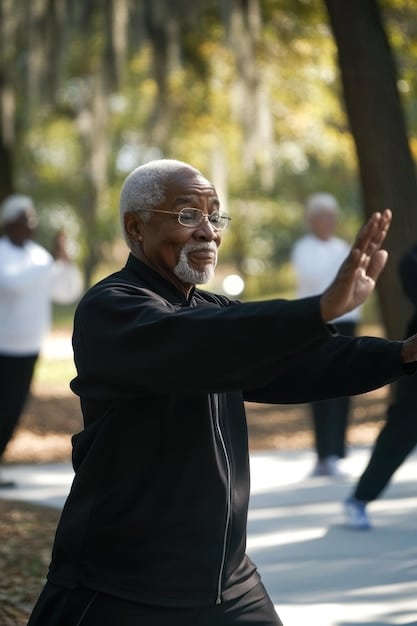
The Mindful Movement Connection
The integration of physical movement with mental focus in Tai Chi creates a unique pathway to stress reduction. Unlike passive forms of relaxation, Tai Chi actively engages the mind and body, providing an outlet for accumulated tension. The gentle stretching and fluid transitions help release physical tightness often associated with stress, while the mental concentration acts as a form of active meditation that clears the mind. This holistic approach makes it particularly effective for managing chronic stress and anxiety.
- Enhanced Serenity: The focus on breath and movement cultivates a tranquil state, reducing mental agitation.
- Improved Sleep Quality: Reduced stress levels often translate into better and more restorative sleep for seniors.
- Emotional Regulation: Regular practice can improve one’s ability to manage emotions and respond calmly to challenging situations.
The calming effects of Tai Chi extend beyond the practice session itself, offering seniors sustainable coping mechanisms for daily stressors and contributing to a more peaceful and resilient outlook on life.
Physical Health Benefits Beyond Balance
While balance improvement is a primary draw for seniors, Tai Chi offers a comprehensive suite of physical health benefits that contribute significantly to overall well-being. Its low-impact nature makes it suitable for individuals with varying levels of mobility, and consistent practice can lead to measurable improvements across several physiological systems.
One notable benefit is enhanced flexibility and range of motion. The flowing, continuous movements gently stretch muscles and connective tissues, improving joint mobility and reducing stiffness commonly associated with aging. This increased flexibility can make everyday tasks easier, from reaching for objects to bending down, thereby enhancing quality of life and maintaining independence.
Strengthening and Cardiovascular Health
Despite its gentle appearance, Tai Chi effectively builds muscle strength, particularly in the lower body and core. The slow, controlled movements require sustained muscle engagement, acting as a form of isometric and isotonic exercise. This progressive strengthening helps support joints, improve posture, and contributes to better overall physical function. Furthermore, the rhythmic breathing and continuous movement can also offer mild cardiovascular benefits, improving circulation and heart health without overexertion.
- Improved Joint Mobility: Gentle, flowing movements lubricate joints and increase their range of motion.
- Muscle Toning: Sustained engagement during forms builds strength, especially in legs, core, and arms.
- Enhanced Posture: Core strengthening and body awareness contribute to better postural alignment.
- Better Circulation: Deep breathing and movement aid in blood flow throughout the body.
The cumulative effect of these physical benefits contributes to greater stamina, reduced pain from conditions like arthritis, and an overall feeling of increased vitality, allowing seniors to engage more fully in their daily activities.
Accessibility and Adaptability of Tai Chi for All Seniors
One of Tai Chi’s most compelling advantages for the senior population is its remarkable accessibility and adaptability. Unlike many forms of exercise that require specialized equipment, high levels of fitness, or specific environments, Tai Chi can be practiced almost anywhere, anytime, and tailored to suit individual needs and physical limitations.
Whether performed standing or seated, indoors or outdoors, in a group class or alone, the fundamental principles remain the same. Instructors can modify movements to accommodate mobility issues, chronic pain, or even those recovering from surgery. This flexibility ensures that Tai Chi is not exclusive to highly mobile seniors but genuinely inclusive, allowing a broad spectrum of older adults to experience its benefits.
Tailoring Practice to Individual Needs
For seniors with limited mobility, seated Tai Chi offers an equally effective way to engage with the practice, focusing on arm movements, breathing, and mental concentration. Those with balance concerns can practice near a wall or use a chair for support until their confidence and stability improve. The emphasis is always on gentle progression and listening to one’s body, rather than pushing beyond comfortable limits.
- Chair-Based Practice: Ideal for seniors with significant mobility challenges or those seeking extra support.
- Group vs. Solo: Can be enjoyed in a communal setting for social interaction or practiced individually for personal reflection.
- Progression at Your Pace: Movements can be simplified or made more complex as individual strength and comfort improve.
This inherent adaptability makes Tai Chi a sustainable practice that seniors can integrate into their lives long-term, providing consistent health benefits regardless of evolving physical conditions or lifestyle changes.
Getting Started with Tai Chi: Tips for Seniors
Embarking on a Tai Chi journey is a rewarding experience, and for seniors, the first step is often the most important. Fortunately, beginning a practice is simpler than one might imagine, with numerous resources available to guide newcomers. Finding a suitable class or instructor is key, as proper guidance ensures movements are performed correctly and safely, maximizing benefits and preventing injury.
Look for classes specifically designed for seniors, often labeled as “senior Tai Chi” or “adaptive Tai Chi,” offered at community centers, senior living facilities, or local gyms. A good instructor will emphasize foundational principles, gentle progression, and the importance of listening to one’s body. They will also be adept at modifying movements to suit individual capabilities, ensuring a safe and beneficial experience for everyone.
What to Look for in a Class
When selecting a Tai Chi class or program, consider a few practical aspects. Observe a class if possible to determine if the pace and atmosphere suit your preferences. Ask about the instructor’s qualifications and their experience working with older adults. Ensure the environment is comfortable and safe, with adequate space for movement. Most importantly, remember that consistency is more valuable than intense effort, especially when starting.
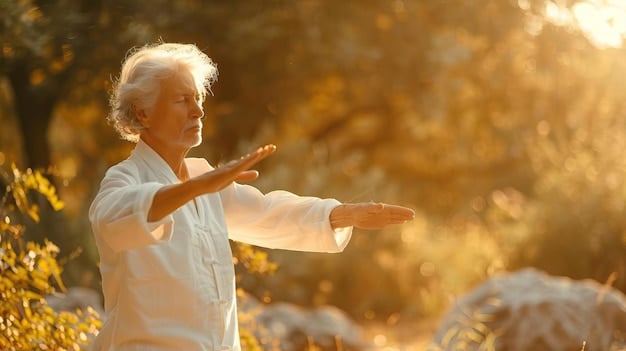
- Qualified Instructor: Seek certified instructors with experience teaching older adults.
- 適応性のあるクラス (Adaptive Classes): Prioritize classes that offer modifications for various physical abilities.
- Comfortable Attire: Wear loose, comfortable clothing and flat, supportive shoes.
- Patience and Persistence: Tai Chi is a journey, and improvement comes with consistent, gentle practice.
Starting with a gentle approach, attending classes regularly, and embracing the philosophy of patience and mindfulness will pave the way for seniors to unlock the full potential of Tai Chi, enhancing their balance, reducing stress, and fostering a profound sense of well-being.
| Key Point | Brief Description |
|---|---|
| 🧘♀️ Improved Balance | Reduces fall risk by enhancing proprioception and strengthening stabilizing muscles. |
| 😌 Stress Reduction | Mindful movement and deep breathing promote mental calmness and lower cortisol levels. |
| 🤸♀️ Enhanced Flexibility | Gentle, flowing movements improve joint mobility and range of motion. |
| 💪 Muscle Strength | Builds subtle strength, particularly in the lower body and core, improving physical function. |
Frequently Asked Questions About Tai Chi for Seniors
▼
Consistency is key. Most studies suggest practicing Tai Chi at least two to three times a week, for 30 to 60 minutes per session, to observe noticeable improvements in balance and stress reduction. Daily short sessions can also be highly beneficial.
▼
Yes, Tai Chi is generally very safe and highly adaptable. Movements can be modified to be performed sitting down or with support, making it suitable for those with limited mobility, arthritis, or other chronic conditions. Always consult a healthcare provider before starting any new exercise.
▼
While Tai Chi offers comprehensive benefits, it complements rather than replaces other exercises. It excels in improving balance, flexibility, and mental well-being. Combining it with light aerobic activity or strength training provides a more well-rounded fitness regimen tailored to senior health needs.
▼
Tai Chi reduces stress through its meditative component, gentle rhythmic movements, and focused breathing. It calms the central nervous system, lowers heart rate and blood pressure, and promotes mindfulness, diverting attention from stressful thoughts and fostering inner peace and tranquility.
▼
The “10% improvement” highlights a common anecdotal or research-supported range of benefit that individuals might experience over time. While specific percentages vary by individual and study, it signifies a measurable and significant positive change in these areas, making Tai Chi a worthwhile pursuit.
Conclusion
In summation, the ancient art of Tai Chi offers a compelling and multifaceted array of benefits for seniors, addressing crucial aspects of healthy aging. Its gentle, fluid movements are not merely an exercise but a holistic practice that profoundly impacts both physical and mental well-being. From significantly enhancing balance and reducing the risk of falls to providing a powerful antidote to stress and anxiety, Tai Chi stands as a testament to the power of mindful movement. Its accessibility and adaptability further underscore its value, making it a sustainable and enjoyable practice for almost every older adult seeking to improve their quality of life. Embracing Tai Chi can lead to greater independence, a calmer mind, and an overall more vibrant experience of the senior years.
